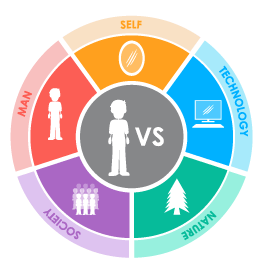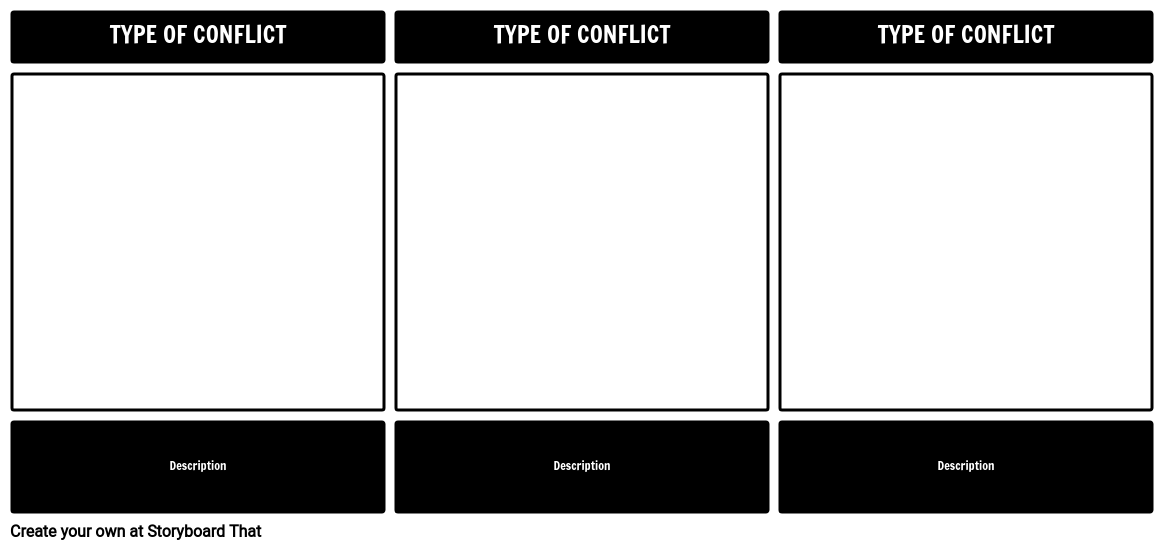Lesson Plan Overview
Storyboarding is an excellent way to focus on types of literary conflicts.
Having students create storyboards that show the cause and effect of different types of conflicts strengthens analytical thinking about literary concepts. Have your students choose an example of each literary conflict and depict them using the storyboard creator. In the storyboard, an example of each conflict should be visually represented, along with an explanation of the scene, and how it fits the particular category of conflict.
Examples of Literary Conflict in The Color Purple
MAN vs. MAN
Celie becomes murderous when she discovers that Albert has been keeping Nettie’s letters from her all these years. With Shug’s help, she manages to keep her rage under control until Shug and Grady can get her to Memphis with them, but not before she lashes out at Albert.
MAN vs. SELF
Celie doesn’t see herself as deserving of love and respect. She feels dumb in comparison to everything that Nettie has learned in school, and she feels dull in her looks in comparison to Shug. Celie doggedly lives her life with Albert, raising his children, because she thinks that’s the only option she has.
MAN vs. SOCIETY
The common Christian belief is that Christians need to do all that they can to please God; however, Shug believes that the way to please God is to enjoy the things in life that make us happy. This leads Shug to go where she wants, love who she wants, and do what she wants, which all goes against the traditional teachings of Christianity, and what was expected of women and their behavior in the South during this time period.
Template and Class Instructions
(These instructions are completely customizable. After clicking "Copy Activity", update the instructions on the Edit Tab of the assignment.)
Student Instructions
Create a storyboard that shows at least three forms of literary conflict in The Color Purple.
- Identify conflicts in The Color Purple.
- Categorize each conflict as Character vs. Character, Character vs. Self, Character vs. Society, Character vs. Nature, or Character vs. Technology.
- Illustrate conflicts in the cells, using characters from the story.
- Write a short description of the conflict below the cell.
Lesson Plan Reference
Student Rubric
(You can also create your own on Quick Rubric.)
| Proficient | Emerging | Beginning | Try Again | |
|---|---|---|---|---|
| Conflict Identification | Student identifies correct major conflicts and uses strong, clear textual evidence to support choice. | Student identifies correct major conflict and uses few or unclear details to support their choice. | Student identifies incorrect major conflict, and uses some details from the text to support their choice. | Student does not attempt to identify major conflict or identifies incorrect major conflict with no explanation. |
| Understanding Outcome | Student clearly shows the outcome of the conflict and its effects on the protagonist with evidence from the text. | Student shows the outcome of the conflict and its effect on the protagonist, but some evidence is unclear. | Student shows the outcome of the conflict, but does not examine its effect on the protagonist and uses some vague textual evidence. | Student does not clearly show the outcome of the conflict or use textual evidence. |
| Character | Storyboard includes all required characters and clearly names them. Goes above and beyond by adding additional details. | Storyboard includes all required characters and clearly names them. | Storyboard includes protagonist and antagonist but leaves out other required characters. | Storyboard does not include the names of required characters. |
| Storyboard | Student clearly shows effort to convey the setting the scene of the book | Student attempts to convey setting and scene of the book, but lacks some clarity. | Student does not clearly convey the setting and scene. | Student makes little or no attempt to convey the setting or scene. |
| Spelling and Grammar | Student uses exemplary spelling and grammar. There are no errors. | Student makes a minor error in spelling and grammar. | Student makes several minor errors in spelling and grammar. | Student makes many errors in spelling and grammar; little attempt at spellchecking. |
Lesson Plan Overview
Storyboarding is an excellent way to focus on types of literary conflicts.
Having students create storyboards that show the cause and effect of different types of conflicts strengthens analytical thinking about literary concepts. Have your students choose an example of each literary conflict and depict them using the storyboard creator. In the storyboard, an example of each conflict should be visually represented, along with an explanation of the scene, and how it fits the particular category of conflict.
Examples of Literary Conflict in The Color Purple
MAN vs. MAN
Celie becomes murderous when she discovers that Albert has been keeping Nettie’s letters from her all these years. With Shug’s help, she manages to keep her rage under control until Shug and Grady can get her to Memphis with them, but not before she lashes out at Albert.
MAN vs. SELF
Celie doesn’t see herself as deserving of love and respect. She feels dumb in comparison to everything that Nettie has learned in school, and she feels dull in her looks in comparison to Shug. Celie doggedly lives her life with Albert, raising his children, because she thinks that’s the only option she has.
MAN vs. SOCIETY
The common Christian belief is that Christians need to do all that they can to please God; however, Shug believes that the way to please God is to enjoy the things in life that make us happy. This leads Shug to go where she wants, love who she wants, and do what she wants, which all goes against the traditional teachings of Christianity, and what was expected of women and their behavior in the South during this time period.
Template and Class Instructions
(These instructions are completely customizable. After clicking "Copy Activity", update the instructions on the Edit Tab of the assignment.)
Student Instructions
Create a storyboard that shows at least three forms of literary conflict in The Color Purple.
- Identify conflicts in The Color Purple.
- Categorize each conflict as Character vs. Character, Character vs. Self, Character vs. Society, Character vs. Nature, or Character vs. Technology.
- Illustrate conflicts in the cells, using characters from the story.
- Write a short description of the conflict below the cell.
Lesson Plan Reference
Student Rubric
(You can also create your own on Quick Rubric.)
| Proficient | Emerging | Beginning | Try Again | |
|---|---|---|---|---|
| Conflict Identification | Student identifies correct major conflicts and uses strong, clear textual evidence to support choice. | Student identifies correct major conflict and uses few or unclear details to support their choice. | Student identifies incorrect major conflict, and uses some details from the text to support their choice. | Student does not attempt to identify major conflict or identifies incorrect major conflict with no explanation. |
| Understanding Outcome | Student clearly shows the outcome of the conflict and its effects on the protagonist with evidence from the text. | Student shows the outcome of the conflict and its effect on the protagonist, but some evidence is unclear. | Student shows the outcome of the conflict, but does not examine its effect on the protagonist and uses some vague textual evidence. | Student does not clearly show the outcome of the conflict or use textual evidence. |
| Character | Storyboard includes all required characters and clearly names them. Goes above and beyond by adding additional details. | Storyboard includes all required characters and clearly names them. | Storyboard includes protagonist and antagonist but leaves out other required characters. | Storyboard does not include the names of required characters. |
| Storyboard | Student clearly shows effort to convey the setting the scene of the book | Student attempts to convey setting and scene of the book, but lacks some clarity. | Student does not clearly convey the setting and scene. | Student makes little or no attempt to convey the setting or scene. |
| Spelling and Grammar | Student uses exemplary spelling and grammar. There are no errors. | Student makes a minor error in spelling and grammar. | Student makes several minor errors in spelling and grammar. | Student makes many errors in spelling and grammar; little attempt at spellchecking. |
How Tos about Identifying Literary Conflict in The Color Purple
Organize a Class Discussion on Literary Conflict
Encourage students to share and compare their storyboard examples in a group discussion. This promotes deeper understanding as students explain their choices and hear diverse perspectives on conflict in The Color Purple.
Guide Students to Find Textual Evidence
Ask students to locate and quote specific passages from the novel that illustrate each type of conflict. This builds critical reading skills and supports their storyboard scenes with concrete examples.
Model Creating a Literary Conflict Anchor Chart
Demonstrate how to create a visual anchor chart displaying the definitions and examples of each conflict type. Hang it in your classroom as a quick reference for students during reading and discussions.
Facilitate Peer Feedback Sessions
Organize opportunities for students to review each other's storyboards and provide constructive feedback. This strategy enhances collaboration and helps students refine their understanding of literary conflicts.
Frequently Asked Questions about Identifying Literary Conflict in The Color Purple
What are the main types of literary conflict in The Color Purple?
The Color Purple features several types of literary conflict, including Character vs. Character (Celie vs. Albert), Character vs. Self (Celie's struggle with self-worth), and Character vs. Society (Shug's defiance of traditional roles). Each conflict drives character development and highlights key themes in the novel.
How can students identify examples of conflict in The Color Purple?
To identify examples of conflict in The Color Purple, students should look for moments where characters face opposition—either from others, themselves, or society. Encourage students to note actions, dialogue, or decisions that show tension or struggle, then categorize each as a specific type of conflict.
What is an easy classroom activity for teaching literary conflict using The Color Purple?
A simple and effective classroom activity is to have students create storyboards that depict different conflicts from The Color Purple. Each panel should show a conflict type, illustrate the scene, and include a brief explanation of how it fits the category.
Why is it important for students to understand literary conflict in novels like The Color Purple?
Understanding literary conflict helps students analyze character motivations, plot development, and themes. In The Color Purple, conflicts reveal deeper social issues and personal growth, making literary analysis more meaningful and relevant.
Can you give examples of Character vs. Self and Character vs. Society conflicts from The Color Purple?
Yes. An example of Character vs. Self is Celie's struggle with her self-esteem and self-worth. An example of Character vs. Society is Shug's rejection of traditional gender and religious expectations in the Southern U.S.
More Storyboard That Activities
Color Purple, The
Testimonials

“By using the product, they were so excited and they learned so much...”–K-5 Librarian and Instructinal Technology Teacher

“I'm doing a Napoleon timeline and I'm having [students] determine whether or not Napoleon was a good guy or a bad guy or somewhere in between.”–History and Special Ed Teacher

“Students get to be creative with Storyboard That and there's so many visuals for them to pick from... It makes it really accessible for all students in the class.”–Third Grade Teacher
© 2026 - Clever Prototypes, LLC - All rights reserved.
StoryboardThat is a trademark of Clever Prototypes, LLC, and Registered in U.S. Patent and Trademark Office








